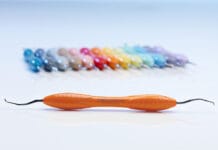As dental hygienists, we have the opportunity to spend an estimated 45 to 60 minutes with our patients at each appointment. Performing intraoral and extraoral examinations offers us the ability to be dental healthcare detectives; we can sometimes identify patient’s potential health issues before the patients recognize them themselves.
I can remember an occasion when a patient asked me about the “dark ring around their neck.” I was practicing dental hygiene for approximately 4-5 years at that time. I asked the patient when they recognized the “dark ring.” They said they noticed it a few weeks prior and tried to scrub it off vigorously during daily showers, but the “dark ring” would not fade. I asked the patient if they noticed the “dark ring” anywhere else on their body. The patient stated they did not. During the extraoral examination, I did recognize the “dark ring” around their neck.
The hyperpigmented area seemed to be what doctors would diagnose as acanthosis nigricans; a significant finding that could be related to an endocrine disorder such as type 2 diabetes.1 In other cases, the lesion could be related to birth control medications.2 Another cause could be related to cancers of the gastrointestinal tract or cancers of the genitourinary system.2 Acanthosis nigricans appear as hyperpigmented patches commonly located in areas of the skin that crease, wrinkle, or gather, such as the neck, armpits, groin area, and knuckles of the hands and toes.1,2
I asked the patient if they experience polyphagia (frequent hunger), polyuria (frequent urination), or polydipsia (frequent thirst). The patient replied they did not. I followed up by asking if diabetes is common in their family. The patient mentioned that their grandparents had diabetes, and their PCP had told them they are pre-diabetic. I followed up with another question inquiring the date they last visited their PCP for blood testing to evaluate their HbA1C level. The patient stated they were due for their annual checkup. I recommended they schedule an examination and present the hyperpigmented area to their primary care physician (PCP).
When treating the patient, I recognized and notated their marginal gingival tissue was generally erythematous with generalized bleeding upon probing. I reviewed oral homecare, such as brushing and flossing to reduce biofilm accumulation, allowing the patient to demonstrate following instruction. I emphasized the importance of optimal homecare and recommended the benefits of a daily food diary as something they could bring with them to their PCP’s office. Food diaries can offer valuable information revealing hidden sugars in foods that can negatively impact blood sugar levels; hidden sugars can negatively impact health, especially those with prediabetes or diabetes.
Dialogue is important in cases such as these. Referring patients to their primary care providers is also imperative. PCP’s can follow through with the necessary complete blood count (CBC) screenings and any other tests beneficial in determining the patient’s medical diagnosis. Dental hygienists are much more than “teeth cleaners.” Dental hygienists are educated professionals and have a responsibility to utilize evidence based research when caring for their patients.
Be a lifelong learner – take a general and oral pathology continuing education course and a nutrition continuing education course. Be a dental hygiene detective! Your patients just may thank you!
Before you leave, check out the Today’s RDH self-study CE courses. All courses are peer-reviewed and non-sponsored to focus solely on high-quality education. Click here now.
Listen to the Today’s RDH Dental Hygiene Podcast Below:
References
- Ibsen, O.A.C., Phelan, J. (2013). Oral Pathology for the Dental Hygienist (6th ed.). Saunders.
- Myers, S.L., Curran, A.E. (2014). General and Oral Pathology for the Dental Hygiene Practice. F. A. Davis Company.












